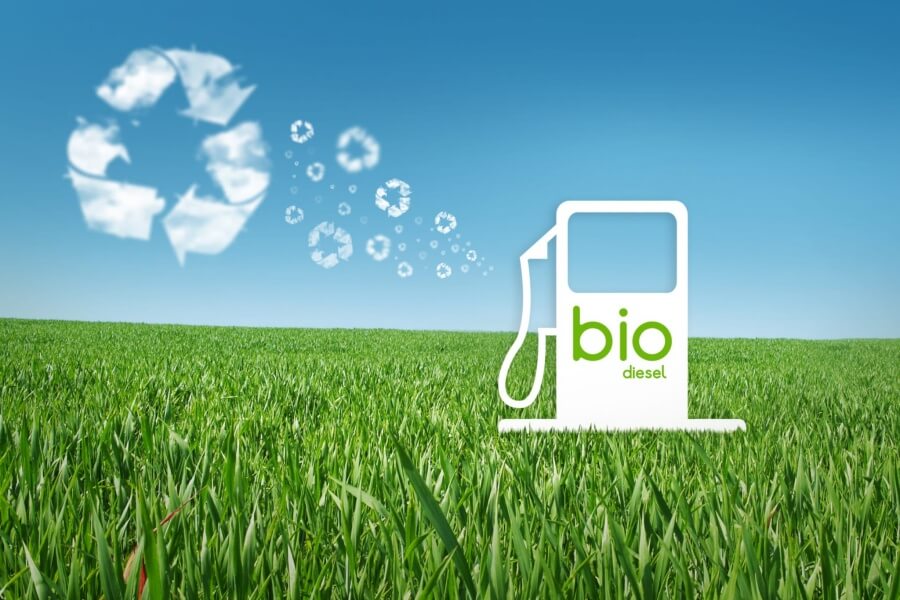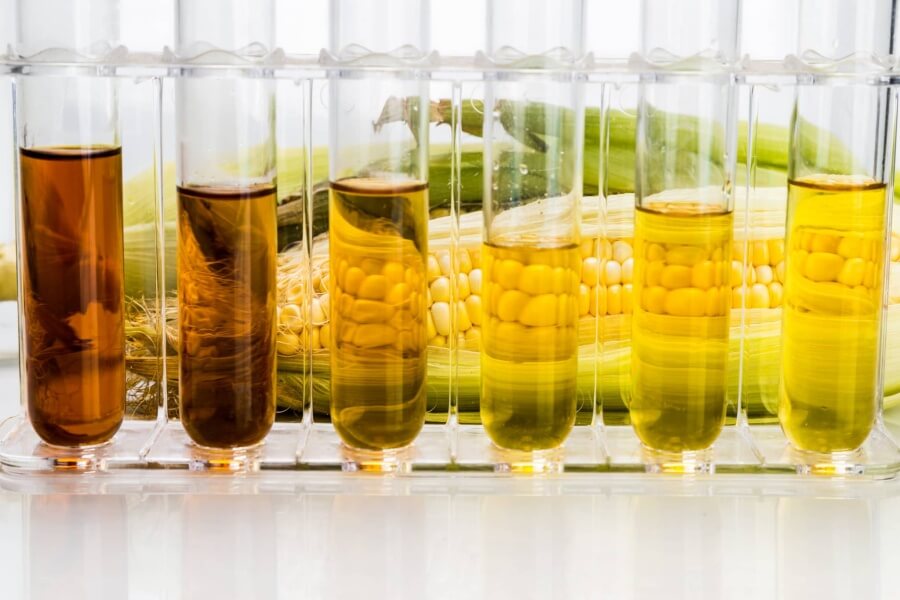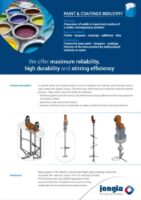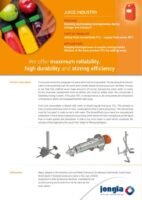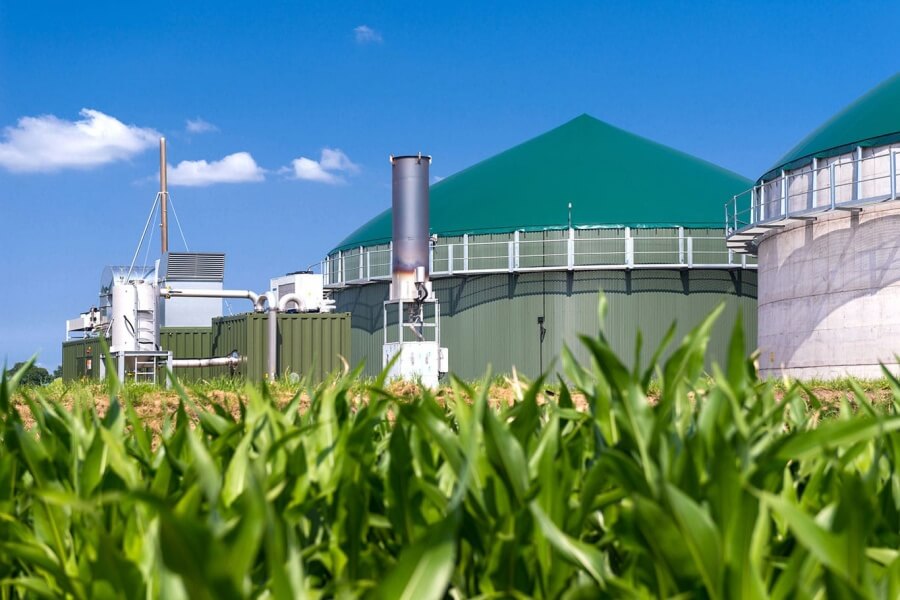
Biogas
Roerwerken, mengers en mengelementen voor de biogasindustrie
Tanks met kleine, middelgrote of grote capaciteit die worden gebruikt in de industrie voor hernieuwbare energie, zoals voor vergisters, vereisen op maat gemaakte roerwerken om te mengen, de inhoud homogeen te houden, drijflaag/schuim te voorkomen en bezinking van vaste stoffen tot een minimum te beperken. Jongia biedt klanten in de biogas-, afvalwater- en hernieuwbare-energiesector de beste mengoplossingen: maximale prestaties met de laagste TCO (Total Cost of Ownership).
Jongia’s mengapparatuur is bij uitstek geschikt voor toepassingen in de biogas- en hernieuwbare-energiesector.

Wij streven naar maximale prestaties tegen de laagste TCO

Wat is biogas?
Biogas is een hernieuwbare energiebron die wordt geproduceerd door de afbraak van biologisch materiaal zoals voedselresten en mest. Dit proces produceert methaangas, dat rechtstreeks kan worden verbrand om warmte of energie te produceren.
De hoeveelheid biogas die over de hele wereld wordt geproduceerd, neemt snel toe. In 2017 bereikte de wereldproductie een recordhoogte van ongeveer 545 miljoen ton. Het Internationaal Energieagentschap (IEA) verwacht dat de jaarlijkse productie tegen 2040 2 miljard ton zou kunnen bereiken, een stijging met meer dan 50% sinds 2010.
Biogas ontstaat nadat planten en dieren organisch materiaal afbreken in een zuurstofvrije atmosfeer, een proces dat aërobe vergisting wordt genoemd. Dit gebeurt in de natuur, maar het kan ook gebeuren in door de mens gecreëerde omgevingen zoals afvalwaterzuiveringsinstallaties en composteringsoperaties voor voedselafval.
Anaërobe vergisting vindt plaats onder zuurstofarme omstandigheden – een andere vorm van gisting. Anaërobe vergisting produceert biogas, dat voornamelijk bestaat uit methaangas, samen met kleinere hoeveelheden koolstofdioxide en waterstofsulfide. Bovendien genereert anaerobe vergisting een vloeibaar effluent, bekend als digestaat, dat rijk is aan nutriënten en organische verbindingen die als meststof kunnen worden gerecycleerd.
De term “biogas” verwijst specifiek naar het gasvormige deel van de productstroom die ontstaat bij anaërobe vergisting, hoewel de termen “digestaat” en “biosolids” vaak door elkaar worden gebruikt.
Waarvoor kan biogas worden gebruikt?
Biogas is een hernieuwbare energiebron die wordt gewonnen uit afvalproducten zoals mest, rioolslib, landbouwafval en afval van de voedselverwerking. Biogas kan worden omgezet in elektriciteit, warmte, vloeibare brandstoffen of meststoffen.
De wereldmarkt voor biogas zal de komende tien jaar naar verwachting gestaag groeien tot 32 miljard dollar in 2023. Deze groei wordt voornamelijk gedreven door de toenemende vraag naar schone energiebronnen en het groeiende bewustzijn over de milieueffecten van fossiele brandstoffen.
Er zijn echter nog enkele uitdagingen te overwinnen. Voor de productie van biogas is bijvoorbeeld veel land nodig, en veel landen hebben niet genoeg ruimte voor stortplaatsen. Bovendien is de technologie die nodig is om biogas te produceren duur en vergt zij aanzienlijke investeringen.
Top entry roerwerken voor het Digester proces, zijn uitgerust met een uniek reststirer concept dat bezinking van vaste stoffen tot een absoluut minimum beperkt en meer biogas genereert in vergelijking met de oplossing van andere leveranciers.
Om productverlies en verontreiniging van de omgeving door lekkage van de afdichting te voorkomen, zijn wij erin geslaagd een robuuste en betrouwbare drievoudige afdichting te ontwerpen voor roerders met zijaansluiting.
Bovendien leveren onze ervaren procesingenieurs expertise in rapporten en kenmerken van productmonsters (bijvoorbeeld slib/digestaat), of stellen zij u CFD-analyses ter beschikking die door een onafhankelijk adviesbureau zijn gemaakt.
Ook bieden wij procesgaranties die u zelf of via een onafhankelijk adviesbureau naar keuze kunt valideren!
Contacten met de bio-industrie

Tom Pruymboom
Sales Director
Area Worldwide

Jan Siert Tjeerdsma
Projectmanager
Technical Specialist
Biogebaseerd & Milieu Verwant Artikelen

Kunstmatige intelligentie en machinaal leren schuiven op naar mengtechnologie
In het steeds veranderende landschap van industriële technologie maken kunstmatige intelligentie (AI) en machinaal leren (ML) grote vooruitgang in verschillende sectoren, waaronder mengtechnologie. Jongia Mixing Technology loopt voorop in deze revolutie en integreert geavanceerde sensortechnologie met geavanceerde gegevenswetenschap om mengprocessen
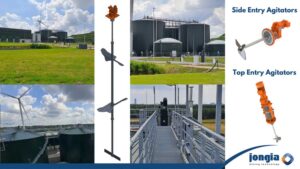
Jongia Mixing Technology’s biogasproductie programma
Biogasproductie optimaliseren met Jongia’s innovatieve technologie Jongia loopt voorop in het verbeteren van de biogasproductie met zijn geavanceerde mengoplossingen. In de biogasindustrie is effectief mengen de sleutel tot het maximaliseren van de energieproductie, het minimaliseren van het energieverbruik en het
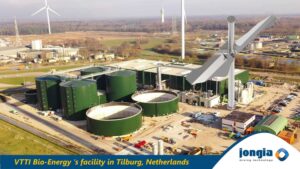
VVTI Biogas Tilburg
VTTI Biogas Tilburg ontwikkelt een nieuwe bio-energie faciliteit, gericht op de verwerking van organisch afval. De fabriek zal naar verwachting jaarlijks ongeveer 23 miljoen kubieke meter biogas produceren. Een deel hiervan zal worden omgezet in groen gas voor het Nederlandse
Biogas en biomassa: de overeenkomsten en verschillen
Biomassa en biogas zijn beide biobrandstoffen. Ze kunnen worden verbrand om energie te produceren. Biomassa is echter de vaste, organische materie. Biomassa bestaat al duizenden jaren, sinds onze voorouders voor het eerst manieren vonden om plantaardige materialen zoals hout, stro en mest te gebruiken om vuur te maken. Naarmate de technologie verbeterde, leerden de mensen voedsel te koken zonder afhankelijk te zijn van vuur en ontwikkelden zij nieuwe methoden om graan tot meel te verwerken. Deze processen bleken nuttig voor het maken van brood, koekjes, cake en pap. In feite is het woord “brood” afgeleid van het Latijnse woord panis dat “meel” betekent.
Tegenwoordig werken veel elektriciteitscentrales op een biomassa van samengeperste houtpellets – een bijproduct van de bosbouw en de meubelproductie. Dit soort brandstof wordt “biomassa” genoemd, terwijl het proces om er energie van te maken “bio-energie” wordt genoemd. Bio-energie is een van de snelst groeiende vormen van hernieuwbare energie.
Het belangrijkste verschil tussen biomassa en biogas is dat biomassa het uitgangsmateriaal is en biogas het eindproduct. Wanneer je iets als hout verbrandt, verandert de resulterende hitte water in stoom. Stoom drijft turbines aan die elektriciteit opwekken. Biogas is vergelijkbaar met aardgas, behalve dat het minder kooldioxide bevat. Aardgas bestaat voornamelijk uit methaan, maar er zit ook wat ethaan en propaan in.
Biogas kan afkomstig zijn van verschillende bronnen, waaronder rioolwaterzuiveringsinstallaties, stortplaatsen, veehouderijen en zelfs menselijk afval.
De voordelen van biogas
Biogas is de meest overvloedige vorm van energie op aarde. In feite bestaat het overal waar organisch materiaal is, zoals voedselresten, mest en plantaardig materiaal. Dit geldt ook voor het menselijk lichaam. Een persoon produceert ongeveer 30 pond vast afval per dag. Als je bedenkt dat elk pond vast afval ongeveer 2 liter vloeistof bevat, kunnen we zeggen dat mensen genoeg brandstof produceren om een auto bijna drie maanden achter elkaar te laten rijden.
Stel je nu voor dat je die brandstof zo opslaat dat hij bruikbaar is. Stel je voor dat we ons vast afval omzetten in iets dat onze huizen, bedrijven en zelfs auto’s van energie voorziet. Je zou kunnen denken dat dit klinkt als science fiction, maar dat is het niet. Er zijn al gemeenschappen in heel Amerika die dat doen.
De meeste biogasproductie-installaties maken gebruik van anaerobe vergisting, waarbij organisch materiaal zonder zuurstof wordt afgebroken. Anaerobe vergisters werken goed met organisch afval omdat er geen luchtdichte containers voor nodig zijn. Ze laten de organische materialen gewoon op natuurlijke wijze vergaan onder gecontroleerde omstandigheden. Bijproducten zijn biogas, warmte, waterdamp en meststoffen.
Hoewel veel mensen biogas associëren met veehouderijen, kan het ook afkomstig zijn van gemeentelijke waterzuiveringsinstallaties. Afvalwaterzuiveringsinstallaties genereren biogas tijdens de behandeling van afvalwater. Deze biogassystemen vangen het methaan op dat ontsnapt terwijl de organische vaste stoffen uit het behandelde afvalwater bezinken.
Er bestaan verschillende technologieën om biogas om te zetten in elektriciteit, waaronder motoren, turbines, compressoren, generatoren, microturbines en brandstofcellen. De meeste van deze technologieën werken op vergelijkbare wijze en zetten biogas rechtstreeks om in elektriciteit. Sommige apparaten gebruiken het biogas echter ook als verwarmingsmedium, waarbij stoom of warm water wordt geproduceerd.
Naast het opvangen van biogas is een ander voordeel van anaerobe vergisting dat er geen schadelijke gassen vrijkomen in het milieu. Methaan is een van de hoofdbestanddelen van biogas. Bij de verbranding van methaan komt kooldioxide vrij, een krachtig broeikasgas. Maar wanneer methaan wordt opgevangen en omgezet in elektriciteit, is het volkomen ongevaarlijk.
Zoals eerder gezegd, kan biogas worden gebruikt om alles aan te drijven, van huizen tot fabrieken en auto’s. Omdat het wordt gewonnen uit organisch afval, wordt biogas beschouwd als een hernieuwbare bron. In tegenstelling tot wind en zon is biogas niet afhankelijk van weerspatronen. In plaats daarvan kan op biogas altijd worden vertrouwd om constante hoeveelheden energie te leveren.


